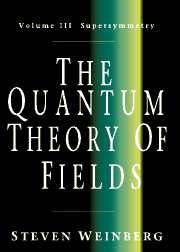Book contents
- Frontmatter
- Contents
- PREFACE TO VOLUME III
- NOTATION
- 24 HISTORICAL INTRODUCTION
- 25 SUPERSYMMETRY ALGEBRAS
- 26 SUPERSYMMETRIC FIELD THEORIES
- 27 SUPERSYMMETRIC GAUGE THEORIES
- 28 SUPERSYMMETRIC VERSIONS OF THE STANDARD MODEL
- 29 BEYOND PERTURBATION THEORY
- 30 SUPERGRAPHS
- 31 SUPERGRAVITY
- 32 SUPERSYMMETRY ALGEBRAS IN HIGHER DIMENSIONS
- AUTHOR INDEX
- SUBJECT INDEX
24 - HISTORICAL INTRODUCTION
Published online by Cambridge University Press: 05 May 2013
- Frontmatter
- Contents
- PREFACE TO VOLUME III
- NOTATION
- 24 HISTORICAL INTRODUCTION
- 25 SUPERSYMMETRY ALGEBRAS
- 26 SUPERSYMMETRIC FIELD THEORIES
- 27 SUPERSYMMETRIC GAUGE THEORIES
- 28 SUPERSYMMETRIC VERSIONS OF THE STANDARD MODEL
- 29 BEYOND PERTURBATION THEORY
- 30 SUPERGRAPHS
- 31 SUPERGRAVITY
- 32 SUPERSYMMETRY ALGEBRAS IN HIGHER DIMENSIONS
- AUTHOR INDEX
- SUBJECT INDEX
Summary
The history of supersymmetry is as peculiar as anything in the history of science. Suggested in the early 1970s, supersymmetry has been elaborated since then into a beautiful mathematical formalism that unites particles of different spin into symmetry multiplets and has profound implications for fundamental physics. Yet there is so far not a shred of direct experimental evidence and only a few bits of indirect evidence that supersymmetry has anything to do with the real world. If (as I expect) supersymmetry does turn out to be relevant to nature, it will represent a striking success of purely theoretical insight.
Chapter 25 will begin the construction of supersymmetry theories from first principles. In the present chapter we shall introduce supersymmetry along chronological rather than logical lines.
Unconventional Symmetries and ‘No-Go’ Theorems
In the early 1960s the symmetry SU(3) of Gell-Mann and Ne'eman (discussed in Section 19.7) successfully explained the relations between various strongly interacting particles of different charge and strangeness but of the same spin. The idea then grew up that perhaps SU(3) is part of a larger symmetry, which has the unconventional effect of uniting SU(3) multiplets of different spin. There is such an approximate symmetry in the non-relativistic quark model, under S (7(6) transformations on quark spins and flavors, analogous to an earlier SU(4) symmetry of nuclear physics that had been introduced in 1937 by Wigner.
- Type
- Chapter
- Information
- The Quantum Theory of Fields , pp. 1 - 24Publisher: Cambridge University PressPrint publication year: 2000
- 1
- Cited by



